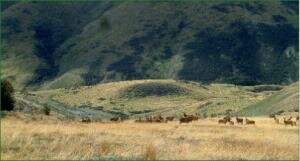website | Farm Profile
A development challenge
 |
The Dunrobin hinds thrive on the hard hill tucker With fawning percentages high, the next challenge is to increase weaning weights
|
10-09-2007 | webmaster
At the front are the paddocks that the Russells have ploughed or over-sown – 90 ha in all, following a programme developed by consultant Peter Desborough, and these are the only improved pastures on the block.
The Russells have been sensible not to get carried away. The front paddocks are on country – rare for New Zealand – where P levels are naturally high; in the mid-20s. They mainly need lime. On the rest of the block, P levels can drop to as low as 6 and that means to get things growing about a tonne of phosphate is needed per hectare, plus lime and trace elements.
A massive fertiliser budget is needed to fund this, but before spending it, it’s important to have scrub weeds – especially matagouri – under control. Otherwise, as Bruce points out, you risk growing a very healthy matagouri forest.
Hence the current focus on matches. Burn-offs are unfashionable these days, but if they’re hot enough and well-controlled, they’re the best way to get rid of the matagouri scrub that infests so much of this country and prevents deer from making the most of the available pasture.
Bruce bemoans the resource consent rigmarole that makes getting council consent for a burn-off more difficult by the year. Helicopters and fire crews have to be on stand-by and the weather conditions need to be perfect. But most of the burns have proved highly successful, with near-total removal of matagouri on the burnt blocks.
The tough hill pastures don’t seem to faze the Russell’s deer. A large proportion of the 2000 hinds have Danish and Eastern blood from stags bought from Walter Somerville’s Arawata stud and David Stevens at Netherdale.
In the past few seasons, fawning percentages have been up at 92–96%, so the main breeding focus now is to build hind weights and weaning weights. “The Eastern influence in the hinds means they are productive, well-behaved and don’t run to fat. But I’d like to get their liveweights up to 125 kg max,” Bruce explains.
About a quarter of the 450 hinds on the home block have been AIed by Deer Improvement for the past two years. Bruce has yet to find out how well the progeny from the AI matings will handle the hill, but better weights are already evident. This year’s AI weaner stags were up an average of 4 kg on their herd mates and the weaner females up 3 kg, with the heaviest stag fawn weighing 72 kg on 15 February.
At present, about half of the 1900 weaners off the hill reach a killable weight by March, with the balance gone by their second winter. The immediate target is to get all stags to killable weights before January.
Then the stags get drafted off to easier country, and the hinds are brought in, given their annual Tb test and sent back on to the hill where they are block grazed through the winter – starting in the high areas, then working down towards the better lower country.
The yards where they are handled are simple and efficient, based on a Jed Newlands design. Their main role is to handle deer for tagging, Tb testing, trucking and offloading. Anything more sophisticated is done in the yards on the home block, a legacy of the Bernard Pinney days, or at Avondale where all the stags are velveted.
In August, when most of the standing hay and anything green has been chewed out, the gate to a 20 ha paddock of kale is opened for the hinds to feed at will. They’re not locked in and, as Bruce notes with interest, some stay up on the hill where they appear to be quite happy.
The kale and about 250 bales of baleage – with another 250 in reserve – are the only supplements fed. In a cold Southland spring, these may be the main sources of energy until early October.
Come spring, the gates are all opened and the hinds move back to the hills and find themselves a nice spot to fawn. They are then left to themselves until weaning.
“We tried late weaning on the hill in our first year here, but it wasn’t very successful,” Bruce says. “We couldn’t build a bank of feed, so the fawns dragged the hinds down. We run out of feed in the crucial August/September/ period. The following year’s fawning percentage said it all.
“Mid-March is best. We’ve usually got good weather which helps the fawns settle easier and gives the hinds a chance to start gaining condition before going to the stag.”
At weaning the hinds are give a mineral supplement and the fawns are tagged, given pour-on and Rumensin and then trucked to Avondale.
At Avondale the weaners are fed on grass and given silage treated with copper chelate. Both Dunrobin and Avondale are marginally copper deficient for deer, and in Bruce’s view this can be most economically addressed by methods other than the use of copper bullets.
In the late autumn, Brian drafts off the heaviest 500 yearling hinds and keeps them separate until they have been mated and pregnancy tested and sends the best 300 back to the Dunrobin hill block to fawn.
 Printable View Printable View
|
